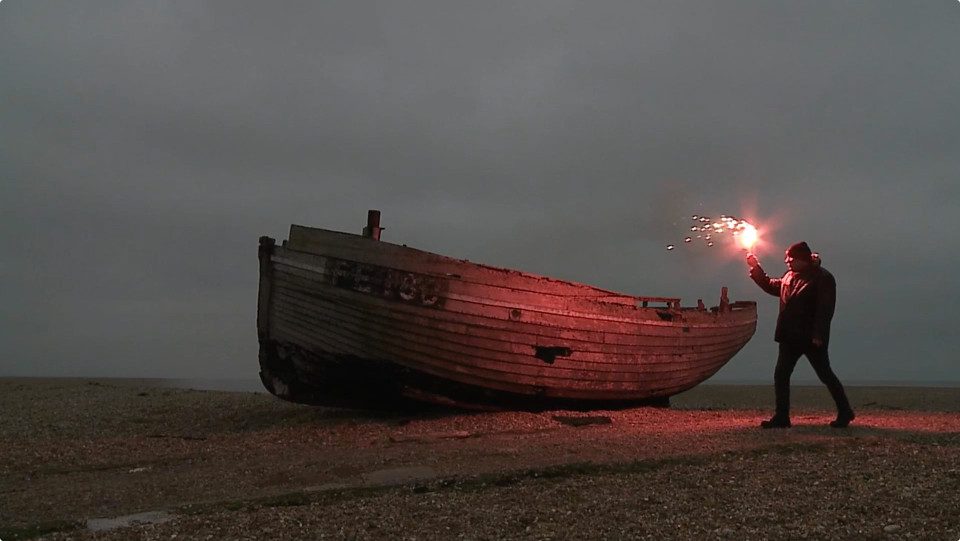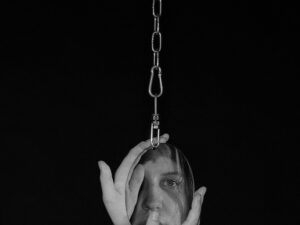In a new commission from Film London Artists’ Moving Image Network, artist Richard Heslop has created an experimental film in response to a radio play by Simon Armitage. The collaborative project, which is a tribute to British filmmaker Derek Jarman, draws inspiration from Theodore Gericault’s The Raft of the Medusa (1819). Prior to his death in 1994, Jarman was considering making a film based on the renowned painting which depicts a group of desperate men, abandoned on a raft at sea. Taking clues from Jarman’s notebooks and discussions with previous collaborators, Heslop has produced a striking visual piece which uses Armitage’s radio drama as a soundtrack. We speak to Heslop about the collaborative making process responding to Armitage’s play and working with composer Simon Fisher Turner.
A: The Raft of the Medusa is a multi-platform piece created by Simon Armitage, Simon Fisher Turner and yourself. Can you talk a little about the collaborative making process?
RH: Simon Armitage, Jeremy Mortimer and I had a meeting at the BBC in London over a year ago to talk about themes, ideas and ways in which we could celebrate Derek Jarman’s aesthetic, spirit and life and make a completely new piece of work at the same time. We talked about projects that Derek had been thinking of doing and one of the projects that came up was The Raft Of the Medusa which had been a play about an AIDS support group and an undercover journalist who infiltrates the group to do a salacious piece of gutter journalism. The journalist is rumbled and stabbed with what he thinks is an infected needle from one of the AIDS patients and briefly gets to understand the fear and panic that carrying such a deadly virus at that time could create. The title of the film also refers to Theodore Gericault’s Le Radeau de la Meduse which was a political painting about a horrific navel incident in which many working class people were left to fend for themselves after a boat sank. In the meeting we also talked about abandonment and apocalyptic scenarios and films such as Solaris and Stalker by Andre Tarkovsky and his wonderful use of water and liquids as part of the dream-scape and texture of his films. After an hour or two we went our separate ways and Simon went off to write the story with very little input from me after that. I trusted him and I think he trusted me to complement the writing with my own visuals. At the meeting I had mentioned Simon Fisher Turner and his crucial part in the soundtracks of many of Derek Jarman’s later experimental 8mm feature films such as The Garden and The Last Of England and how I felt he should be involved as his music is so evocative of Derek’s aesthetic and atmospheric landscape.
A: Alongside the play by Simon Armitage, what inspired you to capture and use the footage featured in The Raft of the Medusa?
RH: My job has been to be both a candle holder for Derek and his aesthetic, and to make a film that is a poetic visualisation of the subtext, atmosphere and emotion of Armitage’s story. I wanted to visually illustrate the film but let my images be almost another level of consciousness. I put in things which would allow the viewer to make mental connections and associations but still allow the viewer to listen to the radio play. There are all sorts of images in this visual gumbo, for instance I used the European space station floating above the Earth as a reminder that if we continue to destroy our beautiful planet then rafts like the space station may be our last refuge. I also used a lot of shots of animals and insects as a reminder that while we play out our little games on this planet there are many other levels of consciousness surviving on the planet with us that might well inherit this earth one day. I also used a lot of “still life” set ups both in the studio and outside as a reference to decay and to the past history of art and the galleries full of paintings of abundance and decadence and plenty in a world that was often harsh and brutal and tragic and where many people went hungry. It’s also a reference to The Raft of the Medusa story of the starving working class left to fend for themselves by the richer passengers and captain who got into the lifeboats with provisions. The current horrific images on the news of daily huge death tolls of drowning refugees from Syria is a constant reminder that nothing much has really changed sadly. Using such a painterly approach was also a reference to Derek Jarman’s painting background.
A: What motivated you to accept the Film London commission, which acts as a tribute to filmmaker Derek Jarman?
RH: Derek was like a second father figure to me back in the mid 1980s and into the early 1990s. He was such a kind, encouraging, impishly mischievous and talented man and storyteller, I was so lucky to have met him when I did. I met him at an event called THE FINAL ACCADAMY which involved William Burroughs and some of the beat poets and the band I was doing multi screen live projections with 23 Skidoo. He saw my work on the big screen, I had about 15 projectors all running at the same time, several of them showing my 8mm work. He saw me as a kindred spirit in film making, using non-linear multi layered collage type construction, like DADA and stuff. He liked what I did and asked if I would work with him on three Smiths videos he had been commissioned to make. Derek was a great collaborator, he gathered around him like minded talented people and gave us the freedom to make magic happen. I wanted to remind people of Derek’s energy and life, and also to make a film that maybe he would have been proud of.
A: How does this work connect to your previous projects and wider research?
RH: Apart from filmmaking I also make collages and paintings so in some ways this was an extension of that practice. Also when I worked in music videos back in the 1980s and 1990s we would be given a finished music track and then would come up with the visuals, this was like that in some ways, I was given a finished radio play and I then came up with the images. I am used to working in this way, I like it. I much prefer none linear narrative, I like disrupting the flow and playing with the viewers minds, I like exciting their nerve endings.
A: Are there any lasting sentiments that you hope the viewer will take away with them after experiencing the film?
RH: I think there are a lot of messages and subliminal symbolism going on in this film, I have tried to make a film that leaves both conscious and subconscious memories. I have also tried to make this film a beautiful visual feast. I think beauty in films is important, it may not always be the obvious beauty but it should be beautiful none the less. I have also tried to make a hypnotic film, one which gets to the subconscious by using slow mixes and pacing and which draws the viewer slowly in to the film so they get the overall message which is for humanity to stop destroying the planet or it will destroy you. And also on a more micro personal level that you can’t control everything and if you try and force love and trust by using force and control you will end up losing everything.
For more information, visit www.richardheslop.com.
See The Raft of The Medusa here.
Further details can be found at www.filmlondon.org.uk.
Credits
1. Still from The Raft of The Medusa. Radio Play by Simon Armitage, Film by Richard Heslop, Film Production by BloodSugar Films. A Cast Iron Radio and Film London Artists’ Moving Image Network production. Supported by Arts Council England.





